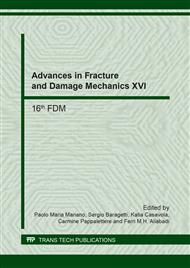p.359
p.363
p.367
p.371
p.375
p.379
p.383
p.387
p.391
Laser Vibrometer Imaging of Delamination Interaction with Lamb Waves Using a Chirp Excitation Method
Abstract:
One method that has shown great potential in visualising and characterising the interaction of guided waves with damage in composites is Laser Vibrometry. A Laser Doppler Vibrometer (LDV) can be used to produce 2D wavefield images of guided Lamb waves but a single scan is very time consuming and normally multiple scans are required at various frequencies in order to determine the best input signal. This paper demonstrates the use of a chirp excitation method requiring only a single scan and a post-processing algorithm to obtain results corresponding to any narrowband signal within the frequency range of the chirp signal. The method was used on an artificially delaminated composite panel and showed that the S0 mode, dominant at higher frequencies, mainly caused mode conversions whilst the A0 mode, dominant at lower frequencies, mainly caused a change in phase and amplitude across the delaminationOne method that has shown great potential in visualising and characterising the interaction of guided waves with damage in composites is Laser Vibrometry. A Laser Doppler Vibrometer (LDV) can be used to produce 2D wavefield images of guided Lamb waves but a single scan is very time consuming and normally multiple scans are required at various frequencies in order to determine the best input signal. This paper demonstrates the use of a chirp excitation method requiring only a single scan and a post-processing algorithm to obtain results corresponding to any narrowband signal within the frequency range of the chirp signal. The method was used on an artificially delaminated composite panel and showed that the S0 mode, dominant at higher frequencies, mainly caused mode conversions whilst the A0 mode, dominant at lower frequencies, mainly caused a change in phase and amplitude across the delamination.
Info:
Periodical:
Pages:
375-378
Citation:
Online since:
September 2017
Authors:
Keywords:
Price:
Сopyright:
© 2017 Trans Tech Publications Ltd. All Rights Reserved
Share:
Citation:


